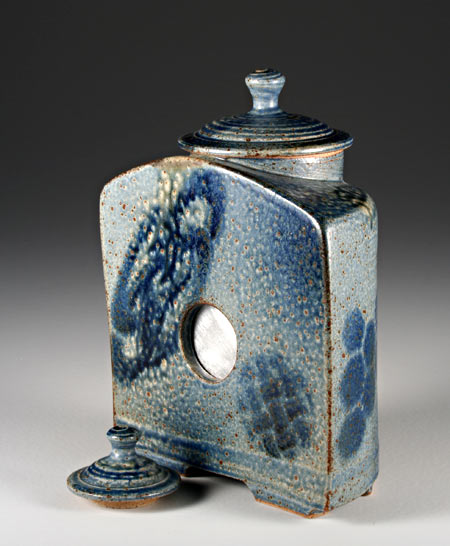
Ceramicist and photographer Steve Irvine has made another dead gorgeous ceramic pinhole camera! Have a look at his pinhole photography, astrophotography, other cameras, and pottery—it’s all exquisite.
Via the f295 Pinhole Photography Forum

Ceramicist and photographer Steve Irvine has made another dead gorgeous ceramic pinhole camera! Have a look at his pinhole photography, astrophotography, other cameras, and pottery—it’s all exquisite.
Via the f295 Pinhole Photography Forum
Paul Beard of A Crank’s Progress blog writes:
You’d think they might mention it on their website, but alas, no.
Anyway, they’re running a contest from July 1 to August 12 [2006]. Any Holga or pinhole images is acceptable (need not be a modded Holga—not that that stopped me from grabbing one of their kits: $25 for a Holga, 2 rolls of film, and a few feet of gaffer tape on a 120 spool).
Call Brent @ 206 624 1100 for more info.
Via the f295 Pinhole Forum
This one’s via Dennis at Captured Starlight, who writes:
Daniel G’s work continues to amaze and surprise me. Daniel has long been into aerial photography using RC model planes (with small digital cameras controlled from the ground with servos). More recently, Daniel has taken up pinhole photography (some of his previous projects have been posted here previously). All along I’ve secretly been hoping that Daniel would combine his two hobbies and make an aerial pinhole camera. Well, Daniel took me up on my offer of a free pinhole and used it to make exactly that. The results are astonishing!
See the results and follow his progress at Photoplane Pinhole Blog!
Prolific camera builder Eric Molczan published plans for a cheap & easy-looking DIY shutter for pinhole and zone plate cameras.
Check it out at f295
In May, I re-posted Oran Grad’s post from The Online Photographer about a high-speed, ISO 24,000 black and white reversal (slide) film that Kodak’s research department came up with and was quite excited about its implications for pinhole and zone plate photography. Unfortunately, it appears that there wasn’t enough interest and they will not be offering the film commercially.
I received this from them via email:
The purpose of Dr. Gilman’s presentation, "A High-Speed Direct Positive Photothermographic System", was to share information on an innovative technology and to showcase its potential. Eastman Kodak Company invents and evaluates many technologies annually for possible commercial applications. However, Kodak does not have any plans to make this technology available in a commercial product.
I guess it’s time to start pushing the hell out of ISO 3200 film. I’ve successfully pushed Kodak T-MAX 3200 (TMZ) to 12800 using T-MAX developer and will see if I can coax another stop out of it or Delta 3200 to achieve the equivalent speed and report back with the results. It’ll be a negative instead of a positive and will have boulder-sized grain, but I’m still really excited about the prospect of handheld, freeze-frame, normal shutter speed pinhole photography.
The great thing about making cameras is that they’re really dead simple: box + light detector (film or sensor) + hold for light = camera. When there’s no lens involved, there’s heaps of room for creativity. While many people opt for more traditional materials like wood, metal, foamcore, or modify an existing camera, some people go all out.
Here’s a [doubtless incomplete] roundup of some of the stranger things I’ve seen people make pinhole cameras out of, to date. Note that many of these links have construction instructions!
If you’re looking to build your own, f295 Lensless Photography Discussion Forum is a great resource full of freakishly helpful camera hackers.
Know of anything I missed? Tell us!
f295 member Longbow3 is building a double-sided, multi-focal length camera! It shoots 2×3 and is 30mm on one side and 90mm on the other. Sweeeeet!
Check it out at f295
The July 2006 issue of B&W Black and White Photography Magazine is dedicated to pinhole photography! It features work by Katie Cooke and several members of the f295 Pinhole Photography Forum (among others), as well as four articles on pinhole photography. Ms. Cooke’s work alone is worth the price of the issue and there’s lots of other talent in there, so check it out!
A book of Edward Levinson‘s pinhole photographs will be published June, 2006. The book is titled "Timescapes Japan – A Pinhole Journey" and contains images of Japan as seen through the eyes of Edward Levinson and his pinhole cameras. Selected black and white photographs from three series of work from 1993 to recent work with brief text in English and Japanese.
The featured photographs are from Levinson’s "Healing Landscapes", "Sacred Japan", and "Japanese Cityscapes" series.
The book is being published by Nippon Camera Publishing Co. and will sell for 3,000 yen (tentative price about $30 US)
For more information, see Edward Levinson’s website.
Via Pinhole Visions
The Birds and the Bees portrays a breadth of interpretations, as the photographers attach human states of being such as joy, sorrow, growth and death to this well-known phrase
Karen Crisp photographs exotic and invasive plants, investigating the unsettling qualities that can be present in these environments.
Paul Pachter portrays the immediate landscape of his garden of 20 years, expressing aspects of his personal history.
Isabella Pachter collects images of preserved and mounted animals and nature scenes to create collages that comment on the portrayal of nature in the west.
Kellie Gray explores the nature of existence and questions our individual realities using digital stills captured from hours of video tape.
Part of the Auckland Festival of Photography 2006 [blogged previously], this exhibition features a range of photographic approaches, encompassing ‘pure’ large format photography, pinhole photography, manipulated and re-photographed images, and digital stills capture.
Dates: 7–24 June, 2006
Opening reception: Tuesday, 6 June, 2006, 7:00pm
The show is at Artstation, 1 Ponsonby Rd, Newton, Auckland, New Zealand
Via Pinhole Visions